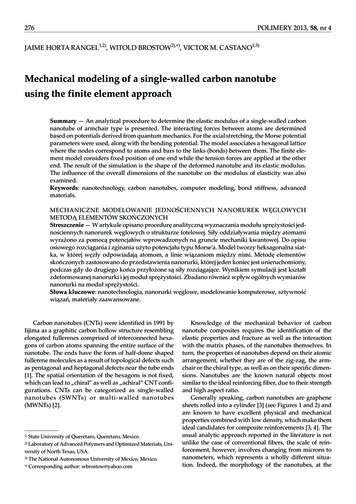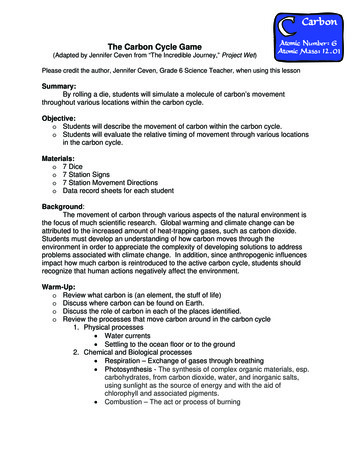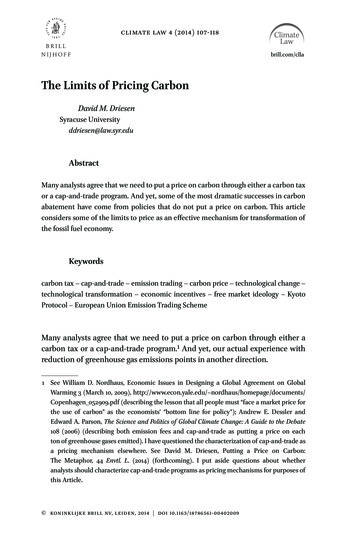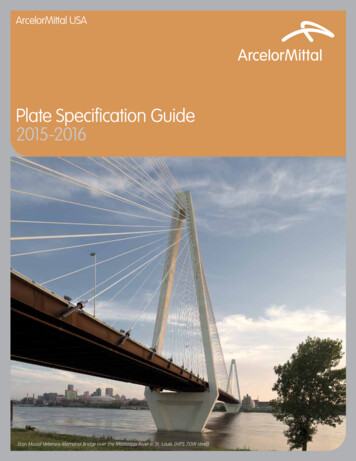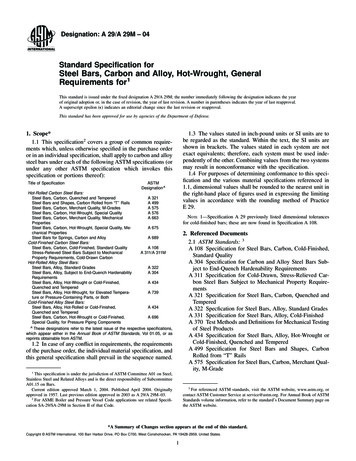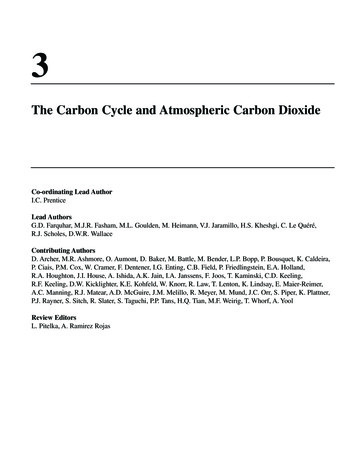
Transcription
Performance Analysis of Carbon Nanotube Interconnectsfor VLSI ApplicationsNavin Srivastava and Kaustav BanerjeeDepartment of Electrical and Computer Engineering, University of California, Santa Barbara, CA 93106{navins, kaustav}@ece.ucsb.eduAbstractThe work in this paper analyses the applicability of carbonnanotube (CNT) bundles as interconnects for VLSI circuits, whiletaking into account the practical limitations in this technology. Amodel is developed to calculate equivalent circuit parameters fora CNT-bundle interconnect based on interconnect geometry. Using this model, the performance of CNT-bundle interconnects (atlocal, intermediate and global levels) is compared to copperwires of the future. It is shown that CNT bundles can outperformcopper for long intermediate and global interconnects, and canbe engineered to compete with copper for local level interconnects. The technological requirements necessary to make CNTbundles viable as future interconnects are also laid out.preferred candidates. The scope of this work is limited to suchbundles of single-walled carbon nanotubes that are best suited forinterconnect applications.Carbon nanotube bundle structures have recently been demonstrated and their metallic conducting properties reported in theliterature [4, 12, 13, 14]. Fig. 1(b-d) shows different strategiesreported in the literature that can potentially be used for forminginterconnects and vias using carbon nanotube bundles. As research in the processing of carbon nanotube interconnects progresses, the performance of this novel technology needs to beevaluated vis-à-vis copper in order to ascertain whether they canbe feasible alternatives to copper interconnects.1. IntroductionThe resistance of copper interconnects, with cross-sectionaldimensions of the order of the mean free path of electrons ( 40nm in Cu at room temperature) in current and imminent technologies [1], is increasing rapidly under the combined effects of enhanced grain boundary scattering, surface scattering and the presence of the highly resistive diffusion barrier layer [2]. The steeprise in parasitic resistance of copper interconnects poses seriouschallenges for interconnect delay [1] (especially at the global levelwhere wires traverse long distances) and for interconnect reliability [3], hence it has a significant impact on the performance andreliability of VLSI circuits.In order to alleviate such problems, changes in the materialused for on-chip interconnections have been sought even in earliertechnology generations, for example the transition from aluminumto copper some years back. Carbon nanotubes have recently beenproposed as a possible replacement for metal interconnects infuture technologies [4, 5]. Carbon nanotubes (CNTs) are graphenesheets rolled up into cylinders with diameter of the order of ananometer. Depending on the direction in which CNTs are rolledup (chirality), they demonstrate either metallic or semi-conductingproperties (see Fig. 1(a)). Because of their extremely desirableproperties of high mechanical and thermal stability, high thermalconductivity and large current carrying capacity [6, 7, 8], CNTshave aroused a lot of research interest in their applicability asVLSI interconnects of the future. However, the high resistanceassociated with an isolated CNT (greater than 6.45 KΩ) [9] necessitates the use of a bundle (rope) of CNTs conducting current inparallel to form an interconnection [4, 5]. Moreover, due to thelack of control on chirality, any bundle of CNTs consists of metallic as well as semi-conducting nanotubes (the semi-conductingCNTs do not contribute to current conduction in an interconnect).CNTs are also classified into single-walled and multi-walled(comprising multiple concentric cylindrical shells) nanotubes.Although multi-walled CNTs (MWCNTs) are predominantly metallic, it is difficult to achieve ballistic transport over long lengthswith them [10, 11]. Single-walled CNTs (SWCNTs) on the otherhand have electron mean free paths of the order of a micron [9].Hence, in the domain of interconnects, metallic SWCNTs are theFigure 1: (a) Different configurations and resulting electrical conduction types of carbon nanotubes depending on the direction alongwhich the graphene sheets are rolled up (chirality) [9]. (b-d) Strategies to form interconnects and vias using carbon nanotube bundles(b: [4], c: [14], d: [15]).While it has been shown that FETs made of carbon nanotubes can be competitive with Si FETs in the sub-20 nm gatelength regime [16], there are few works so far that examine thepractical applicability of CNT bundles as interconnects in VLSIcircuits. These initial works, discussed in the following section,provide a very simplified analysis of CNT interconnections vis-àvis copper and do not consider the capabilities or practical limitations of this emerging technology. Hence there is a pressing needfor a realistic and complete performance analysis of CNT bundleinterconnects as part of a VLSI circuit that takes into account theiradvantages as well as the practical limitations (such as imperfectcontact resistances and the lack of control on chirality) that naturally accompany them. There is also a need to identify the domains of on-chip interconnections (local, intermediate or global)where this novel interconnect technology is most suited to replacecopper. Finally, there is a need to lay out the requirements forprocessing technology in order to make CNT bundles the interconnection material of choice in the near or distant future.This work is aimed at filling these gaps in the existing literature. A comprehensive analysis of the performance of CNTbundle VLSI interconnects vis-à-vis copper interconnects is per-
formed in a detailed and realistic manner for the first time. Thisanalysis is used to identify the parameters in CNT bundle interconnects that can be exploited to derive maximum benefit fromthem as well as those that give rise to major limitations in theirapplicability as interconnects.The paper is organized as follows. The following Section 2describes the equivalent circuit model for a CNT that is useful inthe performance analysis of CNT-bundle interconnects and discusses existing work in the literature that compare CNT interconnects with copper. Section 3 presents a detailed discussion of thederivation of equivalent circuit parameters for a CNT bundle interconnect and describes the models used for evaluating interconnect performance. The results of the analysis are presented inSection 4 and the lessons learned are summarized in Section 5.2. Background and Previous Work2.1 Resistivity Increase in Cu Interconnectsl Rd ' 1 RThe equivalent circuit model for an isolated single-walledcarbon nanotube [17] is shown schematically in Fig. 3. The modeland its components are explained in detail in the following gure 3: Equivalent circuit model [17] for an isolated SWCNT,length less than the mean free path of electrons, assuming ideal contacts.The resistivity of wires with dimensions in the range of, orless than, the mean free path of metal (copper: 40 nm at roomtemperature) has been modeled and experimentally verified onsub-100 nm copper wires [2]. The resistivity model is based onthe Fuchs-Sondheimer model for surface scattering of electrons(Eq. 1) and the theory of Mayadas and Shatzkes for the scatteringof electrons at grain boundaries (Eqs. 2 and 3) [2]. Here ρ0 isresistivity of the bulk material, p is the fraction of electrons scattered specularly at the surface, d is width of the wire, l is meanfree path, R is the reflectivity coefficient that denotes the fractionof electrons that are not scattered by the potential barrier at a grainboundary, and d' is the average distance between grain boundaries.(1)3lρ 1 (1 p )ρ04d(2)ρ01 1 α 3 α 2 α 3 ln 1 ρ α 3 2α 2.2 Equivalent Circuit Model for an Isolated Single Walled Carbon Nanotube (SWCNT)(3)The combined effects of these phenomena, along with thepresence of a finite diffusion barrier layer that is needed for copper interconnects and reduces the effective copper conductingarea, cause a sharp rise in the resistivity of interconnects whendimensions are of the order of the mean free path of electrons.Fig. 2 shows the values of Cu resistivity at sub-90 nm technologynodes when these effects are taken into account. It can be observed that the resistivity of Cu increases many times over its bulkvalue of 1.9 µΩ-cm. The values p 0.6 and R 0.5 are used in thesecalculations as reported in [2] based on experimental observations.Figure 2: Cu interconnect resistivity as a result of barrier scattering,grain boundary scattering and finite barrier layer thickness (at120 C).Resistance of an Isolated SWCNTThe conductance of a carbon nanotube is evaluated usingthe two-terminal Landauer-Buttiker formula. This formula statesthat, for a 1-D system with N channels in parallel, the conductanceG (Ne2/h)T, where T is the transmission coefficient for electronsthrough the sample [9]. Due to spin degeneracy and sublatticedegeneracy of electrons in graphene, each nanotube has four conducting channels in parallel (N 4). Hence the conductance of asingle ballistic single-walled CNT (SWCNT) assuming perfectcontacts (T 1), is given by 4e2/h 155 µS, which yields a resistance of 6.45 KΩ [9]. This is the fundamental resistance associated with a SWCNT that cannot be avoided [18]. As shown inFig. 3, this fundamental resistance (RF) is equally divided betweenthe two contacts on either side of the nanotube.h(4)RF 4e 2The mean free path of electrons (the distance across whichno scattering occurs) in a CNT is typically 1 µm [9, 19, 20]. ForCNT lengths less than 1 µm, electron transport is essentially ballistic within the nanotube and the resistance is independent oflength (6.45 KΩ). However, for lengths greater than the mean freepath, resistance increases with length as shown in Equation 5[21], where L0 is the mean free path and L is the length of theCNT. This has also been confirmed by experimental observations[15, 20]. In the equivalent circuit, this additional scattering resistance would appear as a distributed resistance per unit length toaccount for resistive losses along the CNT length.(5) h LRCNT 4e 2 L0In practice, the observed d.c. resistance of a CNT (at lowbias) is much higher than the resistance derived above. This is dueto the presence of imperfect metal-nanotube contacts which giverise to an additional contact resistance. As observed in [22], making a reliable contact to a CNT is very challenging, and the resistance arising from these imperfect contacts is often so high that itmasks the observation of intrinsic transport properties. The observed resistance for CNTs has typically been in the range of 100KΩ [22, 23], although in a few cases the lowest observed resistance has been seen to approach the theoretical limit of 7 KΩ[23]. In the equivalent circuit, this additional imperfect contactresistance would appear in series with the fundamental resistance(RF) divided equally among the two end contacts as shown for RF.An important consideration for conductance in nanotubes isits dependence on voltage bias. At high electric fields, current
through a nanotube saturates [24]. However, it can easily beshown that a low voltage bias is always applicable in the domainof VLSI interconnect applications, as has also been argued in[25]. In this bias range, the nanotubes display excellent ohmicbehavior [24], hence the resistance models described above arevalid.The total resistance of a CNT is then expressed as the sumof resistances arising from the above three aspects: the fundamental one-dimensional system (CNT) contact resistance, scatteringresistance and the imperfect metal-nanotube contact resistance.Evidently the resistance associated with an isolated CNT is toohigh for realizing an interconnection. Hence, a bundle/rope ofCNTs is needed that has much lower effective resistance and maywork effectively as an interconnection.Capacitance of an Isolated SWCNTThe capacitance of a CNT arises from two sources. Theelectrostatic capacitance (CE) is calculated by treating the CNT asa thin wire, with diameter ‘d’, placed a distance ‘y’ away from aground plane, and is given by the formula in Equation 6 (CE perunit length) [17] for y 2d. The quantities y and d are shown inFig. 4. For d 1 nm, y 1 µm, CE 30 aF/um. This is the intrinsicplate capacitance of an isolated CNT.(6)2πεCE y ln d Figure 4: Isolated conductor, with diameter ‘d’, over a ground planeat a distance ‘y’ below it.The quantum capacitance (CQ) accounts for the quantumelectrostatic energy stored in the nanotube when it carries current.Due to the Pauli exclusion principle, it is only possible to addelectrons into the nanotube at an available quantum state abovethe Fermi energy level. By equating this energy to an effectivecapacitance, the expression for the quantum capacitance (per unitlength) is obtained as shown in Equation 7 [17], where h is thePlanck’s constant and vF is the Fermi velocity. For a carbon nanotube (vF 8x105m/s), CQ 100aF/um [17].CQ 2e 2hvF(7)As a CNT has four conducting channels as described in theprevious sub-section, the effective quantum capacitance resultingfrom four parallel capacitances CQ is given by 4CQ.The same effective charge resides on both these capacitances (CE and 4CQ) when the CNT carries current, as is true for anytwo capacitances in series. Hence these capacitances appear inseries in the effective circuit model shown in Fig. 3.Inductance of an Isolated SWCNTThe inductance associated with an isolated SWCNT can becalculated from the magnetic field of an isolated current carryingwire some distance away from a ground plane, as depicted in Fig.4. In addition to this magnetic inductance (LM), the kinetic inductance is calculated in [17] (following [26]) by equating the kineticenergy stored in each conducting channel of the CNT to an effective inductance. The four parallel conducting channels in a CNTgive rise to an effective kinetic inductance of LK/4. The expressions for LM and LK are shown in Equation 8 below.µ y (8)ln 2π d hLK 22e vFFor d 1 nm and y 1 um, LM (per unit length) evaluates to 1.4 pH/um. On the other hand, LK (per unit length) for a CNTevaluates to 16 nH/um. However, the kinetic inductance (LK) in[26] is derived considering no potential drop along the nanotube;hence it must be treated with care. Since LK LM, the inclusion ofLK can have a significant impact on the delay model for interconnects. In the light of experimental evidence of potential drop appearing along the length of a nanotube [27], LK is excluded fromthe calculations in this work. This is further justified by the experimental measurements of the high frequency characteristics ofcarbon nanotubes recently reported in [28], wherein the largeinductive effects expected due to LK are not observed up to frequencies as high as 10 GHz and the high frequency response iseffectively damped by the nanotube resistance.LM 2.3 Previous Work on Performance of CNT InterconnectsOver the past year, several attempts have been made atevaluating the prospects of CNT-bundle interconnects vis-à-viscopper interconnects of the future. In [3] it is shown that whilecarbon nanotube interconnects can alleviate the severe reliabilitylimitations of future copper interconnects, high density CNT bundles are needed in order to achieve performance comparable tocopper. The work in [29] compares the performance of an isolatedCNT and a flat array of CNTs (see Fig. 6) behaving as interconnections and reports that CNT interconnects do not compare favorably with copper conductors. It is in fact trivial to see that suchconfigurations cannot be compared to copper interconnects due tothe intrinsically high resistance associated with an isolated CNT,hence technologists have always focused on CNT bundles in practice [4, 5]. The coupling capacitance model for CNT interconnectsin [29] considers only the coupling between adjacent CNTs andnot that between bundles forming adjacent interconnects (coupling between adjacent interconnects is considered for copperinterconnects, using a simplistic parallel plate capacitance). Evidently the coupling capacitance between adjacent CNTs formingthe same bundle will always be very high due to their physicalproximity. However, this capacitance does not appear as a loadwhen the CNTs form part of the same interconnection (discussedin further detail in Section 3.2). These shortcomings lead to the(incorrect) conclusion in [29] that carbon nanotube interconnectsare not suitable for VLSI applications.The work in [25] and [30] (in contrast with [29]) shows thatideal, densely packed CNT-bundle interconnects can providesignificant improvement in interconnection speed. The conclusionis, however, based on optimistic assumptions (ideal metalnanotube contacts and completely metallic nanotube bundles)which are far removed from the technological realities of carbonnanotube interconnects. In fact, the significance of the error (anorder of magnitude) in neglecting the imperfect metal-nanotubecontact resistance leads to the wrong conclusion in [31] that a flatarray of CNTs is better suited than copper for local interconnects.The treatment of the critical issue of CNT bundle capacitance alsoraises concern. While [30] avoids the calculation of capacitanceby unjustifiably assuming that the capacitance for a CNT bundleis the same as that for copper interconnects, [31] does not explainhow the same interconnect analysis program can be used to extract capacitances for CNT bundles as for copper interconnects.
The reduction in delay variation and overall digital circuit powerdissipation by the use of a flat array of CNTs [31] also does notreflect reality.All these works fail to comprehend technology issues, suchas imperfect metal-nanotube contacts and the density of metallicCNTs forming a bundle (further complicated by the presence ofsemi-conducting nanotubes). The inclusion of kinetic inductancein the delay model must also be viewed with caution in the lightof the arguments made in Section 2.2. Moreover, they provide noappreciation of the changing scenarios as the interconnect domains change from the local to intermediate and global levels.Contribution of This Work:The work presented here provides the first comprehensiveanalysis of realistic carbon nanotube interconnects in VLSI applications and presents the advantages as well as the limitations ofthis emerging interconnect technology. The domains of on-chipinterconnections where CNT-bundles can be applied in a realisticVLSI circuit are identified along with the requirements that mustbe fulfilled in order to make them viable as replacements for copper interconnects. The equivalent circuit model parameters for aCNT-bundle interconnect based on interconnect geometry arecalculated explicitly for the first time. The performance evaluationof CNT bundle interconnects presented here takes into accountpractical limitations such as the inevitability of imperfect metalnanotube contacts and low density of metallic CNTs in a bundle,as well as circuit parameters like the effect of realistic drivers andloads. In addition, the comparison of CNT-bundle interconnectperformance to copper wires is performed at different interconnectlevels of a VLSI chip for the first time. In the event that CNTbundle interconnects do become a reality in the future, this workconstitutes a significant first step towards developing a CADmethodology for evaluating the performance of such interconnects.3. Equivalent Circuit Parameters for a Bundle ofSWCNTsFigure 6: Flat CNT array and CNT bundles with varying density ofmetallic CNTs. CNT bundle interconnects give much better performance than flat arrays. Present day fabrication techniques cannotensure all CNTs in a bundle are metallic. Varying density of metallicCNTs and presence of semi-conducting CNTs (considered to be insulating [15]) are modeled using inter-CNT distance, x.A CNT-bundle interconnect is assumed to be composed ofhexagonally packed identical metallic single-walled carbon nanotubes. Each CNT is surrounded by six immediate neighbors, theircenters uniformly separated by a distance ‘x’. The densely packedstructure with ‘x’ ‘d’ (CNT diameter), shown in Fig. 6, will leadto best interconnect performance. In practical reality, not all CNTsof a bundle are metallic. Non-metallic CNTs are treated as notcontributing to current conduction and their presence is taken intoaccount by considering “sparsely” populated bundles (Fig. 6). Theexpressions to calculate the number of CNTs in the bundle areshown in Equation 9, where nH is the number of “rows” in theinterconnect bundle, nW is the number of “columns”, nCNT is thetotal number of CNTs, and y denotes the largest integer lessthan or equal to ‘y’. h d (9) w d ; nH nW 1 x3x/2 nHnCNT nW nH ,if nH is even2n 1 nW nH H, if nH is odd2For the case of copper, the interconnect under study is replaced by a solid metal of same dimensions. The rest of this section is devoted to calculation of equivalent circuit parameters forthe CNT-bundle. The calculations for copper interconnect are wellknown already: resistance is calculated as explained in Section 2.1while capacitance and inductance are evaluated using commonfield solvers. Note that inter-metal dielectric constants at differenttechnology nodes are obtained from ITRS [1] predictions andassumed to be same for Cu as well as CNT bundle interconnects.()3.1 Resistance of a CNT-bundleFigure 5: Schematic of interconnect geometry under considerationfor performance comparison between CNT-bundle and copper interconnects.Fig. 5 schematically shows a cross-section of the interconnect structure considered for the performance evaluation of CNTbundle and copper interconnects. Two immediately adjacent metallic wires (held at ground potential) parallel to the interconnection under study are considered, while the interconnect itselfswitches from ‘0’ to ‘1’. The technology dependent wire widths,aspect ratios and dielectric constants follow from the ITRS 2004[1] predictions, and spacing between wires is assumed to be equalto wire width. The distance from substrate for local interconnectsis assumed to be twice the thickness of interconnect (2h, as shownin Fig. 5). Coupling to successive orthogonal metal layers is neglected to keep the analysis simple. For the same reason, finiteconductivity of the substrate and coupling with simultaneouslyswitching wires are also beyond the scope of this work.In order to calculate the effective resistance of a CNTbundle, it is assumed that all CNTs packed into the interconnectstructure are metallic and conducting. The fact that it is, in general, difficult to control the conductance properties of all CNTs inthe bundle is accounted for by considering reduced packing densities as shown in Fig. 6. The CNT-bundle resistance is then givenby Equation 10, where Risolated is the resistance of an isolated CNTand nCNT is the total number of CNTs forming the bundle.Rbundle RisolatednCNT(10)It must be noted that it is implicit in this formulation thatthe coupling between adjacent CNTs of a bundle is weak. However, this is a fair assumption because it has been shown that thereexists a large tunneling resistance ( 2 - 140 MΩ) between theCNTs forming a bundle [15].
3.2 Capacitance of a CNT-bundleThe electrostatic capacitance of a CNT bundle has not beenthe subject of much analysis in the existing literature. The work in[32] studies the electrostatic capacitive coupling to the gate electrode for a flat array of CNT FETs.For the electrostatic analysis of a CNT bundle, each CNT istreated as a classical metal with equal potential over the tube,similar to the approach in [32]. The expression for the intrinsicplate capacitance for an isolated CNT (CE) has been shown before(Equation 6). Fig. 7(a) schematically shows the electrostatic fieldlines emanating from an isolated CNT in this case. Fig. 7(b)shows the corresponding situation for a CNT at the bottom edgeof an interconnect bundle which is surrounded by four otherCNTs.Figure 7: Schematic showing termination of electric field lines for (a)an isolated conductor over a ground plane, and (b) a conductor at thebottom edge of a bundle surrounded by four other conductors.Applying the lessons learned from [32], some insights canbe gained into the electrostatic capacitance of a CNT bundle. Itcan be expected that most field lines will terminate in the surrounding CNTs of the bundle, and the capacitive coupling to thesewill be very high due to the small distance separating them. Aformula was presented in [29] for this capacitance. However, themutual capacitance between CNTs of the same bundle is of noconsequence as it does not place any additional load on the interconnect. This is because, when the CNT bundle carries current, itis assumed that each CNT conducting current is held at the samepotential as any other. The electrostatic capacitance of the bundlethat appears as a load on the interconnect is expected to arisemainly from the CNTs lying at the edges of the bundle (Fig. 8)that are capacitively coupled with the adjacent interconnects (leftand right neighbors) as well as the substrate. The coupling to theadjacent interconnects is expected to be higher than that to thesubstrate due to higher proximity (see Fig. 5).In the absence of actual data on the electrostatic capacitanceof a CNT bundle of these dimensions, the strategy to develop acoarse model for the electrostatic capacitance is based on characterizations of an equivalent and familiar geometry using the fieldsolver FastCap [33]. For this purpose, each CNT in the bundle isreplaced by a square conductor circumscribing the tube as shownin Fig. 8. The intrinsic plate capacitance (CE, refer to Section 2.2)for such an isolated square wire (isolated) is found to be of thesame order of magnitude as that of the corresponding isolatednanotube. The total electrostatic coupling capacitance for eachCNT marked in the Fig. 8 with respect to the left/right neighborsand the substrate are evaluated using FastCap. It is observed thatthe total coupling capacitance for these CNTs can be roughlyrelated to the value of intrinsic plate capacitance (CE) of an isolated conductor with respect to the neighboring interconnects oneither side (left/right). The relations are verified by simulationsacross dimensions corresponding to three different technologynodes (45, 32 and 22 nm) and are summarized in Equations 11.CEn and CEf are the intrinsic plate capacitances (CE from Equation6) calculated for an isolated CNT over a ground plane. CEn iscalculated assuming the ground plane to be at a distance equal tothe separation distance from the "near" adjacent interconnect (inFig. 8, for the CNTs labeled 1, 4, 5 and 6, this distance is 's'). CEfis calculated assuming the ground plane to be at a distance equalto the separation distance from the "far" adjacent interconnect (inFig. 8, for the CNTs labeled 1, 4, 5 and 6, this distance is 's w').CCC 1 (11)C CNT 1 En ; CCNT 2 Ef ; C CNT 4 En 1 ;244 5 CCC CNT5 En ; CCNT 6 Ef24Figure 8: Schematic of CNT-bundle interconnect. Elements labeledwith numbers are the ones characterizing the electrostatic couplingcapacitance of the CNTs along the edges of the bundle. Each circularcross-section CNT is shown along with the circumscribing squareconductor used for FastCap [33] simulations.It is observed, as expected, that the CNTs completely surrounded by other nanotubes (for example CNT #8 in Fig. 8) havea very small electrostatic coupling capacitance to ground compared to those along the edges of the bundle (three orders of magnitude smaller). CNTs nearly completely surrounded as CNT #3have capacitance (to ground) over an order of magnitude less thanthose along the edges. Their contribution to the total electrostaticcapacitance is thus neglected. Using these relations, we calculatethe electrostatic capacitance contributed by each “edge” CNTbased on the corresponding value of CE (Equation 12). The totalelectrostatic capacitance of the bundle is given by the sum of thecontribution from each of these CNTs.nW 23( nH 2)(12)bundleC Ef C En25Since the quantum capacitances of all the CNTs forming aCNT bundle appear in parallel, the effective quantum capacitanceof the bundle is the sum of the individual quantum capacitances.This is shown in Equation 13, where CQCNT is the quantum capacitance of an isolated CNT and nCNT is the total number of CNTsforming the bundle.(13)CQbundle CQCNT nCNTThe effective capacitance (Cbundle) of the series combinationof a quantum and electrostatic capacitance is given by Equation14.111(14) Cbundle CQbundle C EbundleCE 2C En 3.3 Inductance of a CNT-bundleThe inductance of a CNT bundle is given by the parallelcombination of the inductances corresponding to each CNT forming the bundle, as shown in Equation 15, where LCNT is the (magnetic) inductance of an isolated SWCNT (Equation 8).
Lbundle LCNT(15)nCNT4. Performance Comparison of CNT-bundle vs.Copper Interconnects140Dense CNT bundle120L 1 um10022 nm80Node CNT imperfect contacts6032 nmCu wireNode4045 nmNode20 CNT perfect contacts020 25 30 35 40 45 50 55Local Wire Width (nm)Figure 10: (a) Resistance and (b) Capacitance of 1um long local interconnect across different technology generations using denselypacked CNT bundles versus copper wires.Figure 9: Schematic of interconnect circuit used for performanceevaluation. The “interconnect” is replaced by the equivalent circuitrepresentation for CNT-bundle or Cu interconnect.The interconnect structure under study for performancecomparison of CNT-bundle vs. copper interconnects is shownschematically in Fig. 9. The interconnect of length ‘L’ is replacedby the equivalent circuit for CNT-bundle and copper interconnects respectively. The driver is represented here b
for VLSI Applications Navin Srivastava and Kaustav Banerjee Department of Electrical and Computer Engineering, University of California, Santa Barbara, CA 93106 {navins, kaustav}@ece.ucsb.edu Abstract The work in this paper analyses the applicability of carbon nanotube (CNT) bundles as interconnects for VLSI circuits, while
